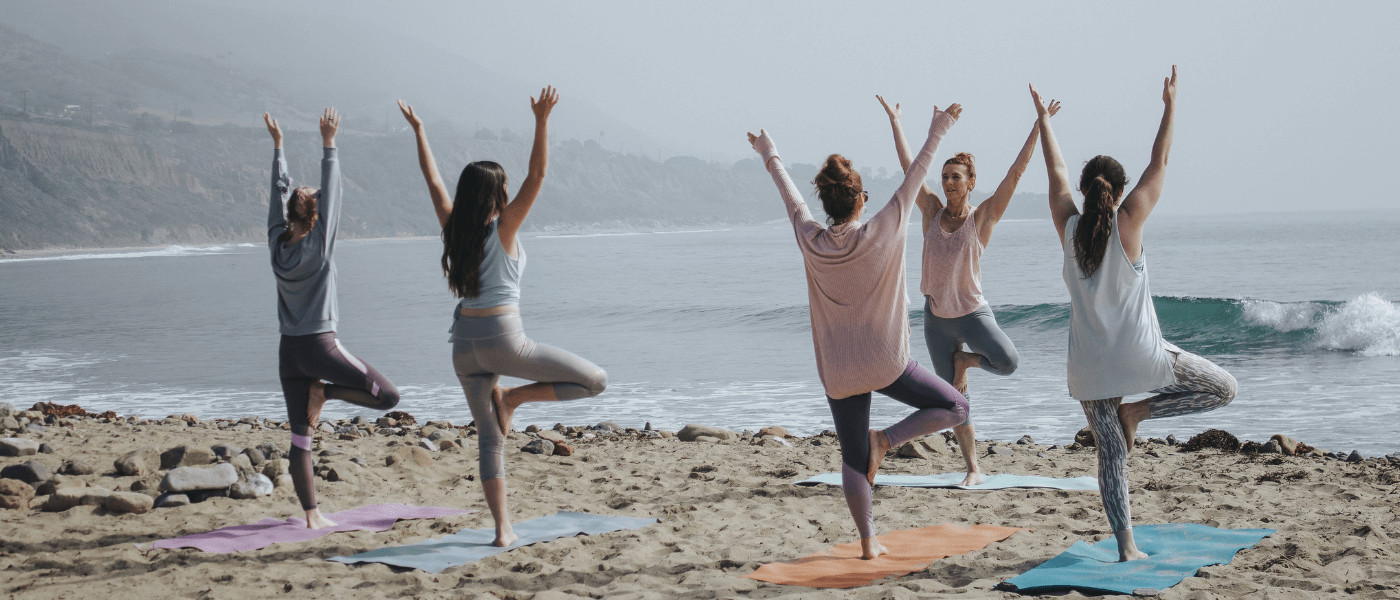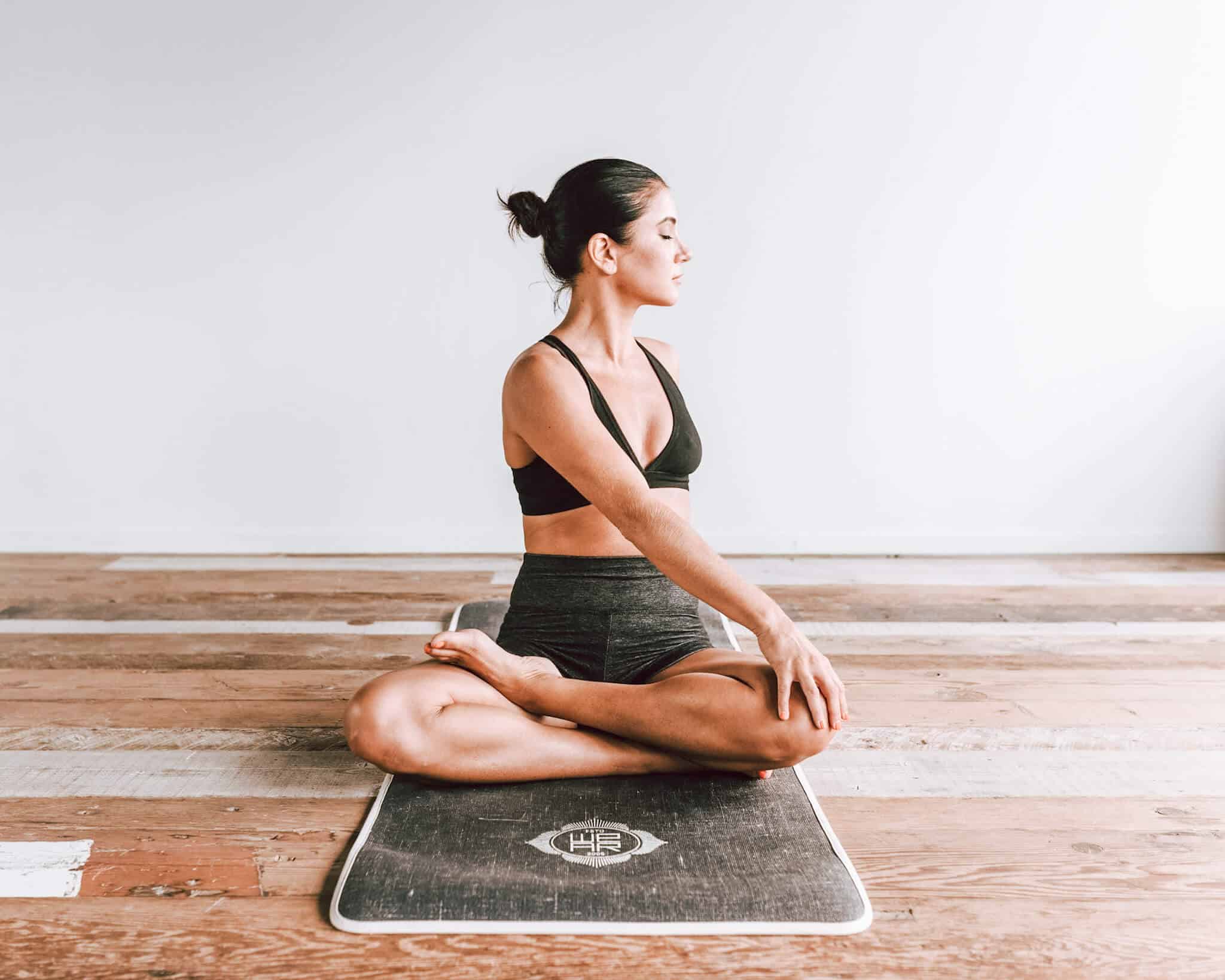Does yoga burn calories? How many?

Those of you who are still suspicious if yoga counts as a workout.
Most people wonder how many calories does yoga burn ; some assume that they can burn calories only with high-intensity workouts. But does yoga burn calories? Many people dismiss yoga as an “easy” activity and not exactly a workout. After all, stretching – what many people relate yoga with — should induce a calming, meditative state, but it won’t exactly help you lose fat— or will it? Anyone who has tried yoga can quickly dispel this misconception.
For example, your legs start to jiggle as you sweat through downward dog, and it’s hard enough to stay and not collapse in this pose.
Or, perhaps your quads start to burn like crazy during your warriors. But, wait, isn’t yoga supposed to be relaxing?
Yes, on occasion. It can, however, be a fat-burning workout as well.
Yoga isn’t typically a high-intensity form of exercise. Instead, we frequently choose more intense activities that get our bodies moving and sweating when burning calories.
But don’t shut the curtains just yet. Many analyses prove that yoga can contribute to losing weight.
How many calories does yoga burn?
Usually, when people begin a new exercise, they want to know its effect and how many calories does it burns if they’re trying to lose weight. While it is true that yoga can help you burn fat because there are so many various styles of yoga to choose from, calculating the exact calories consumed in yoga can be tricky.
Types of Yoga and calories burnt.
Learning how many calories does yoga burn in each different types of yoga will guide what kind of practice you want to start with. There are numerous types of yoga, and regardless of what kind of movement it involves, yoga does burn calories. In addition, depending on the class’s length, weight, fat percentage, and various other genetic variances, different people will burn varying amounts of calories practicing the same practice.
The amount of calories you can burn during an online yoga training or session is determined by several factors.
– the type of yoga
– length and intensity of yoga
– the pace of the class
A celebrity yoga instructor, Mandy Ingber, says that yoga can burn between 180 and 600 calories per Hour. Such a wide range is calculated since there are so many different styles of yoga, ranging from constant movement to a slower, more restorative pace. For example, the number of calories burned during Hatha yoga — a basic style typically taught at a slower pace — will differ from those burned during Bikram yoga, commonly known as hot yoga.

Also, someone weighing 55kgs and performing Hatha yoga for 60 minutes would only burn around 153 calories, while someone weighing 75kgs would burn about 209 calories simultaneously.
If they both did Hot yoga or Bikram (a specific type of hot yoga), the person weighing 55kg would burn around 387 calories, and the one weighing 75kgs would burn roughly 528 calories. So by these estimations, if a female weighing 55kgs performed Vinyasa for 90mins, it can burn up to 720calories.
| Type of Yoga | Female | Male |
| Hatha | 153 | 209 |
| Ashtanga/Power | 259 | 354 |
| Hot/Bikram | 387 | 528 |
| Vinyasa/flow | 480 | 654 |
**check out how many calories does yoga burn at: https://caloriesburnedhq.com/yoga-calories-burned
The table below shows calories burned in each type of yoga class depending on the length of the class.
| MET | 15 MIN. | 30 MIN. | 45 MIN. | 60 MIN. | |
| Hot Yoga | 5 | 107 | 214 | 321 | 429 |
| Bikram Yoga | 5 | 107 | 214 | 321 | 429 |
| Vinyasa Yoga | 5.5 | 118 | 236 | 354 | 472 |
| Hatha Yoga | 2.5 | 54 | 107 | 161 | 214 |
| Ashtanga Yoga | 4 | 86 | 171 | 257 | 343 |
| Power Yoga | 4.2 | 90 | 180 | 270 | 360 |
Following this formula[1]:
= (MET (Metabolic Equivalent of Task) value of the yoga * body weight in kilograms * 3.5) ÷ 200
you can calculate the calories you can burn per minute in any yoga.
Here are the different types of yoga and how the intensity of the workout might differ:
Bikram yoga
This is a type of hot yoga done at a sauna-like temperature. True Bikram yoga is a set of 26 poses performed in a room with a temperature of 105°F and a humidity of 40%. The session will last 90 minutes. Balance, flexibility, and strength are all tested in Bikram yoga postures. And the sauna-like setting makes it seem more complicated than it is.
Vinyasa yoga (or Power yoga)
In Vinyasa yoga, you flow from one pose to the next while keeping your breathing in sync. Vinyasa yoga is usually an intense workout. The combo of motion and bodyweight poses (such as planks) will sweat you crazy. Vinyasa sits somewhere between Hatha and Ashtanga styles, as it is a hybrid of both an emphasis on a lot of movement and endurance. The terms “vinyasa style” and “power yoga” are frequently interchanged in yoga sessions and flows.
Students may expect to repeat each sequence several times in a Vinyasa session and benefit from a relaxing, stress-relieving exercise.
Power yoga is similar to Vinyasa yoga but has more emphasis on athleticism. Of course, the two approaches are different, but they share a common ground in that they are both centered on fitness rather than meditation. Both types are criticized for this reason (and the fact that they are more injury-prone), but they are arguably the types of yoga that can get us the most workout. [2]

Hatha Yoga
Hatha yoga can technically be defined as any yoga that involves movement. Most people, however, think of “Hatha” as mild flow yoga.
A leisurely sequence of poses and stretches is typical in Hatha yoga classes. Like Vinyasa, this type of yoga is breath-based, but with more than one breath each movement. It also refers to the combination of the sun and the moon, “ha” and “tha,” respectively. When a practice is labeled as Hatha, it usually refers to a class that combines basic yoga positions with deep breathing, breath attention, and meditation.
Hatha sessions are ideal for beginners or those who prefer to focus on yoga’s peaceful, leisurely, contemplative parts rather than a physically challenging practice.
Restorative yoga & Yin yoga
If you are sitting in front of your desk after a stressful day, then this type of yoga is for you. Restorative yoga is about relaxing, not exercising. You rest and unleash in a sequence of extended, comfortable positions to lull you into a meditative state. You can even use blankets and pillows!
Yin yoga works deep into the connective tissues to stretch and create change, whereas restorative yoga focuses on healing bodies with specific alignments.
Ashtanga Yoga
Ashtanga yoga entails synchronizing a series of postures with the breath continuously and planned. It has five different asana sequences, and each asana must be learned before moving on to the next.
Ashtanga yoga is a significantly more physically demanding form than Hatha yoga. Ashtanga yoga is designed to help you relax while enhancing your body’s circulation and strength. The rigorous poses also detoxify the organs and muscles by creating a lot of heat and sweat. It’s a challenging practice best suited to more experienced yogis or those who enjoy structure in their approach. It is also known as “eight-limbed” yoga because it emphasizes moral norms; Self-purification and study; Posture; Breathing; Internal listening; Concentration; Meditation; a State of Unity.
So, based on this knowledge, Vinyasa yoga styles hold the most potential for burning off yesterday’s pizza and beer because it is the most aerobic form and connects a range of athletic postures into a “flow.” In addition, of course, Hot yoga (or Bikram yoga) burns more calories since it is done in a sweat-inducing environment, whereas Restorative and Yin forms burn less.
So, to answer the initial question, can yoga be used as a form of aerobic exercise? Yes. As a result, if you maintain your calorie intake constant and add one Hour of yoga to your daily schedule, you should see gradual weight loss.[3]
Does Yoga burn calories when compared to other types of exercise?
Now that you know what types of yoga you can practice, you’ll learn more on how many calories does yoga burn compared to other common exercise activities? Here’s how many that same person would burn to do other things:
| Activity | Calories burned per Hour | |
| Man | Woman | |
| Light Activity: Cleaning house Office work Playing baseball Playing golf | 300 | 240 |
| Moderate Activity: Walking briskly Gardening Cycling Dancing Playing basketball | 460 | 370 |
| Strenuous Activity: Jogging(9min/mile) Playing football Swimming | 730 | 580 |
| Very Strenuous Activity: Running (7min/mile) Racquet ball Skiing | 920 | 740 |
How to bump up the Calories burnt[4]
Discover how many calories does yoga burn to help you maximize the benefits? You can carefully plan your flows to maximize the workout benefits and fat burn in a yoga class. For example, you can include some more demanding postures or challenging poses in planning your flows.
Yoga postures that require strength, balance, and stretching all at the same time can consume more calories because they encourage the body to multitask. complex poses such as dancer, extended side-angle, warrior II, and boat, for example, will burn considerably more calories than vital positions, such as corpse, joyful baby, child’s pose, and hero.[5]
However, as with any physical activity, we must exercise caution to avoid jeopardizing form or function if tiredness is present. As a result, if your body is misaligned or you have trouble balancing, you shouldn’t keep a position as it could cause harm to the body and hurt yourself. [6]
Sun salutations, plank, chair, Chaturanga Dandasana, Lunge, and Dolphin are some of the more strenuous and more challenging poses recommended to include in your yoga routine.
1) Sun salutations
Since Vedic times, this dynamic asana sequence has been practiced for thousands of years. This 8-12 posture sequence, commonly found in Vinyasa courses, is dynamic and ever-changing, integrating breath with movement to warm the muscles thoroughly and create more significant energy. Sun salutations can come in a variety of forms. However, the most fundamental, Surya Namaskar A, is described as follows:
A. Begin in mountain pose (Tadasana) with feet hip-distance apart.
B. Inhale, reach your arms upward (Urdhva Hastasana) over your head.
C. Exhale to forward fold (Uttanasana), hinging from the hips, knees slightly bent, let the forehead tough against the legs.
D. Inhale, get into a low lunge, step one foot back, front knee over ankle. Open chest, hips forward, arms extended to the sky.
E. Exhale to downward-facing dog. Knees straight(in case you can’t, you can slightly bend them), heels and both hands/shoulders pressing down to the mat, chest facing your thighs, tailbone lifted.
F. Inhale to plank. Wrists placed under your shoulders, make sure to lift and engage your core to support your spine.
G. Exhale to Chaturanga Dandasana. Your knees should be lifted (you can keep them down if you can’t), elbows near your ribcage, chest close to the mat but not touching the mat, gaze downward.
H. Inhale to upward-facing dog. Lift and open the heart center, shoulders over the wrists, tops of the feet pressing into the floor, thighs lifted off the mat, keep the spine long.
I. Exhale to downward-facing dog.
J. Inhale to low lunge(the other leg).
K. Exhale to forward fold.
L. Inhale to upward salute.
M. Exhale to finish in mountain pose.
Each transition is facilitated by an inhale or an exhale. The sequence can be sped up or slowed down with longer, challenging holds for advanced practitioners or those who want to burn the maximum number of calories.
2) How many calories does a Plank burn?
Plank is a primary yoga position that offers an excellent full-body stretch. Start in Downward Facing Dog. Then inhale and draw your torso forward until the shoulders are directly over the wrists, torso parallel to the floor. Press your outer arms inward and press firmly into the ground. Keep your tailbone lifted to the ceiling and not sink into the floor. Gaze straight down at the matt. Stay in this position for a few breaths.
Plank pose is as excellent exercise for strengthening your abs. In addition, plank calories burned: between 2 – 5 calories every minute for most people.
Planks help maintain greater calorie burn levels while rest by increasing muscle and boosting metabolism. They’re a great supplement to a well-rounded fitness plan that includes cardio exercises.
3) Chair
Stand in Tadasana Inhale and raise your arms overhead so your biceps are slightly in front of your ears. Keep the arms parallel, palms facing inward. Exhale and bend your knees to parallel your thighs to the floor as possible. Your knees project out over your feet.
Keep your inner thighs parallel and press down to your heels. Firmly keep your shoulder blades against your back. Keep tailbone down toward the floor to keep your lower back long. Stay in this pose for many seconds.

4) High lunge
Start in Downward Facing Dog Pose. Inhale, raise the right leg behind you and then exhale as you step the right foot forward between your hands. Check that the right knee is above the right ankle. Ground through the feet, inhale, lift, sweep your arms out and up, palms facing each other.
Bend your back knee a little, lengthen your tailbone down towards the floor, then extend through the back leg. Open your chest and draw your front ribs down into your torso. Stay for five breaths. Exhale, bring your hands onto the floor by your right foot. Step your right foot back into a Downward Facing Dog pose. Repeat with the left foot coming forward.
5) Dolphin
Begin on all fours on the floor. Get your hands interlaced. Tuck your toes and lift your knees off the floor. Reach your pelvis toward the ceiling, then draw your sit bones toward the wall behind you. Keep your knees bent as you lengthen your spine and broaden across your shoulder blades. Then, gently begin to straighten your legs. Bring your torso and legs into the shape of an “A.” Keep the extension of your whole body. If your upper back begins to round, bend your knees again until your spine is straight.
Another common misconception- Is yoga effective as strength training/resistance exercise?
Did you know how many calories does yoga burn as you build strength while doing your poses? There is a widespread misconception that yoga asana (the physical practice of yoga) is all about stretching and calming down. Yes, we’ve just established that yoga can be a fat-burning workout. However, the remaining question is – if yoga also is a strength training exercise? The answer again is yes. Many different styles of yoga and poses can help you build strength, as well as lose weight too.
Resistance bands and weights are used in some types of strength training, while machines are used in others. However, gravity and your body weight can also help you gain strength. For example, yoga makes you more robust because of this.
Well-balanced yoga practice is more than just flexibility. For example, many yoga postures qualify as isometric workouts. This is because you hold a muscle contraction in a fixed position for a set amount of time without changing the muscle’s length.
A study that looked at the benefits of a 12-week Hatha yoga intervention discovered that, in addition to flexibility, yoga improved muscular strength significantly.[7]
According to John Porcari, Ph.D., head of the clinical exercise physiology department at the University of Wisconsin-La Crosse, yoga can improve muscular strength (your ability to execute one extremely heavy back squat) and endurance (your capacity to do several squats in a row).
Also Read>>> Best Online Yoga Classes
According to a small study(led by Porcari and published in the American Council on Exercise’s magazine), women who did Hatha yoga three times a week were able to complete an average of six more push-ups and 14 more sit-ups after eight weeks compared to those who did not do yoga. Given that they didn’t do any other resistance training, the improvement is significant.
Yoga postures and transitions are similar to bodyweight workouts that build strength. Holding poses is a type of isometric training in which you strengthen the muscles in use by increasing their time under stress.
Consider low plank; this pose strengthens your shoulders, chest, triceps, and core. Beginners and even bulky guys who regularly go weightlifting will find it challenging to perform this pose. But persons who have been practicing yoga for some time will do it for more extended periods with ease.
However, yoga will only get you so far regarding significant strength increases. Because even if you keep increasing the difficulty, you’ll someday tap out in even the most expert poses.

Studies show that even two hours on your mat once a week can help if you’re utilizing yoga to complement your strength-training routine. However, if yoga is your primary source of strength training, you’ll want more. “The best approach to optimize the advantages is to do yoga five days a week and challenge yourself in the positions,” Porcari advises.
By increasing the frequency of your workouts, you’ll be more likely to acquire enough volume to push your muscles week after week.
While most yoga courses can help you gain strength, here are a few that are specifically designed for that purpose:
- Ashtanga. The holds in Ashtanga yoga are usually shorter, but the tempo is fast. This method is particularly beneficial for developing upper-body strength.
- Vinyasa flow. Vinyasa flow is a type of yoga where you flow from one pose to the next. Vinyasa yoga programs are based on Ashtanga yoga and link postures to breath.
- Iyengar. Iyengar yoga is recognized for its extraordinarily long holds, challenging the muscles to engage differently from faster-paced sessions. This type is generally advised for beginners.
- Yoga with weight. If you can’t find the strength you’re looking for in more traditional forms, consider hybrid classes growing in popularity.[8]
How to maximize working your muscles doing yoga
1) Focus on a particular set of poses
Add them to your flow, as already advised in the earlier part of this article.
2) Focus on working your muscles.
You can make a muscle group fire more when you focus on it. And increased muscular activation implies more strength. Pocari says, “It’s almost like you’re utilizing internal biofeedback, or continually monitoring how your body feels and how hard it’s working if you’re purposeful in your positions.”
Then you can make adjustments to your practice as a result.” So think and focus on your glutes burning and firing while you balance during a warrior 3.on your glutes burning and firing while you balance during a warrior 3, for example.
3) Sink into it
You can be in a chair pose, or you can be in a chair pose. You can be in a low lunge, or you can be in a low lunge. You’ll see that some people are only slightly crouched, which only activates the glutes and quads to a limited extent, while others have their legs bent at 90 degrees, which maximizes the advantages of the poses.
The same goes for every other pose. If you pay more attention to pushing your limits in every given pose, you can immediately feel that you are getting much much more workouts in every pose.
Also read >>> Streaming Yoga
4) Hold it and stay focused on breathing
According to Porcari, the longer you hold a pose, the more it tests your strength and endurance. Time spent under tension causes more muscle damage, which helps the muscles recover and become stronger. Like in any strength training, if a particular pose feels easy, it’s probably not doing much for your body as a workout.
So it would help if you challenged yourself to hold longer in a pose till it feels like it’s testing your body strength. Then, while holding the poses, stay focused on the breath, and consciously count your breath from 8-10 each time instead of, say, 5.
5) Be creative
Use your imagination if you want a more significant challenge. When the instructor says chaturanga, you can do two or three rapid push-ups. Or, if you’re in warrior 2, and your arms are outstretched, pulse them. Within the flow, feel things out and create your tiny strength tests. Even slight changes in the angle of your shoulders, hands, or feet can activate different muscles and give you a completely different workout feel. [9]
Yes, yoga helps you lose weight and burn calories; Yes, yoga is good resistance training.
As part of a healthy lifestyle, practicing on your mat a few times a week can help you burn more calories and build more muscles. Whether you don’t want to track how many calories does yoga burn , it will still help you maximize the benefits (depending on the type of yoga you practice) of both weight loss and strength-building exercises.
Ultimately to lose weight, you must burn more calories than you consume. Keep your calory intake constant and add yoga(preferably the more challenging types of yoga) into your daily routine. You will be able to see the scale go down and gradually see your body toned as your muscles get working as well!










